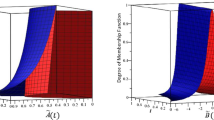Abstract
Least-squares technique is well-known and widely used to determine the coefficients of a explanatory model from observations based on a concept of distance. Traditionally, the observations consist of pairs of numeric values. However, in many real-life problems, the independent or explanatory variable can be observed precisely (for instance, the time) and the dependent or response variable is usually described by approximate values, such as “about \(\pounds300\)” or “approximately $500”, instead of exact values, due to sources of uncertainty that may affect the response. In this paper, we present a new technique to obtain fuzzy regression models that consider triangular fuzzy numbers in the response variable. The procedure solves linear and non-linear problems and is easy to compute in practice and may be applied in different contexts. The usefulness of the proposed method is illustrated using simulated and real-life examples.



Similar content being viewed by others
References
Aguilar R, Ramírez JA, Garrote G, Vazquez M (2002) Kinetic study of the acid hydrolysis of sugar cane bagasse. J Food Eng 55:309–318
Chen Y, Chen L (2006) A non-linear possibilistic regression approach to model functional relationships in product manning. Int J Adv Manuf Technol 28:1175–1181
Chen LH, Hsueh CC (2009) Fuzzy regression models using the least-squares method based on the concept of distance. IEEE Trans Fuzzy Syst 17(6):1259–1272
Chiang JH, Hao PY (2004) Support vector learning mechanism for fuzzy rule-based modeling: a new approach. IEEE Trans Fuzzy Syst 12(1):1–11
Colubi A (2009) Statistical inference about the means of fuzzy random variables: applications to the analysis of fuzzy- and real-valued data. Fuzzy Sets Syst 160:344–356
Coppi R, D’Urso P, Giordani P, Santoro A (2006) Least squares estimation of a linear regression model with LR fuzzy response. Comput Stat Data Anal 51:267–286
Couso I, Sánchez L (2007) Higer order models for fuzzy random variables. Fuzzy Sets Syst 159:237–258
Diamond P (1988) Fuzzy least squares. Inf Sci 46:141–157
Dubois D, Lubiano MA, Prade H, Gil MA, Grzegorzewski P, Hryniewicz O (2008) Soft methods for handling variability and imprecision. Advances in soft computing. Springer, Berlin
Ferraro MB, Coppi R, González-Rodríguez G, Colubi A (2010) A linear regression model for imprecise response. Int J Approx Reason 51:759–770
González-Rodríguez G, Blanco A, Colubi A, Lubiano MA (2009) Estimation of a simple linear regression model for fuzzy random variables. Fuzzy Sets Syst 160:357–370
Hojati M, Bector CR, Smimou K (2005) A simple method for computation of fuzzy linear regression. Eur J Oper Res 166:172–184
Hong DH, Hwang C (2002) Support vector fuzzy regression machines. Fuzzy Sets Syst 138:271–281
Juang CF, Hsieh CD (2009) TS-fuzzy system-based support vector regression. Fuzzy Sets Syst 160:2486–2504
Kao C, Chyu CL (2003) Least-squares estimates in fuzzy regression analysis. Eur J Oper Res 148:426–435
Khemchandani R, Jayadeva, Chandra S (2009) Regularized least squares fuzzy support vector regression for financial time series forecasting. Expert Syst Appl 36:132–138
Kim B, Bishu RR (1998) Evaluation of fuzzy linear regression models by comparing membership functions. Fuzzy Sets Syst 100:343–352
Krätschmer V (2006) Limit distribution of least squares estimators in linear regression models with vague concepts. J Multivariate Anal 97:1044–1069
Nasrabadi MM, Nasrabadi E (2004) A mathematical-programming approach to fuzzy linear regression analysis. Appl Math Comput. 155:873–881
Näther W (2006) Regression with fuzzy random data. Comput Stat Data Anal 51:235–252
Palacios AM, Sánchez L, Couso I (2010) Diagnosis of dyslexia with low quality data with genetic fuzzy systems. Int J Approx Reason 51:993–1009
Puri ML, Ralescu DA (1986) Fuzzy random variables. J Math Anal Appl 114:409–422
Saeman JF (1945) Kinetics of wood saccharification. Hydrolysis of cellulose and decomposition of sugars in dilute acid at high temperature. Ind Eng Chem 37: 43–52
Sánchez L, Couso I, Casillas J (2009) Genetic learning of fuzzy rules based on low quality data. Fuzzy Sets Syst 160:2524–2552
Schweizer B, Sklar A (2005) Probabilistic metric spaces. Dover Publications, New York
Serrunier M, Prade H (2006) Imprecise regression and regression on fuzzy data. A preliminary discussion. IEEE International Conference on Fuzzy Systems. Vancouver, Canada, pp 1506–1511
Tanaka H, Hayashi I, Watada J (1982) Linear regression analysis with fuzzy model. IEEE Trans Syst Man Cybern SMC 12:903–907
Tanaka H, Hayashi I, Watada J (1989) Possibilistic linear regression analysis for fuzzy data. Eur J Oper Res 40: 389-396
Vapnik V (1998) Statistical learning theory. Wiley, New York
Wu B, Tseng NF (2002) A new approach to fuzzy regression models with application to business cycle analysis. Fuzzy Sets Syst 130:33–42
Yang H, Huang K, King I, Lyu MR (2009) Localized support vector regression for time series prediction. Neurocomputing 72:2659–2669
Zadeh LA (1965) Fuzzy sets. Inf Control 8:338–353
Acknowledgments
We are grateful to the referees for their constructive comments which lead to improvements in the paper. This paper has been partially supported by the Junta de Andalucía and projects FQM-245, FQM-268, FQM-178 of the Andalusian CICYE, Spain.
Author information
Authors and Affiliations
Corresponding author
Rights and permissions
About this article
Cite this article
Roldán, C., Roldán, A. & Martínez-Moreno, J. A fuzzy regression model based on distances and random variables with crisp input and fuzzy output data: a case study in biomass production. Soft Comput 16, 785–795 (2012). https://doi.org/10.1007/s00500-011-0769-1
Published:
Issue Date:
DOI: https://doi.org/10.1007/s00500-011-0769-1




